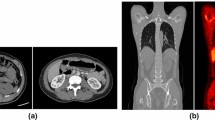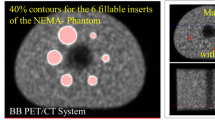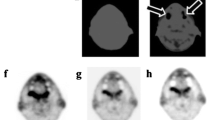Abstract
Purpose
A better understanding of the standardized uptake value (SUV) ranges of fludeoxyglucose positron emission tomography (FDG-PET) is crucial for radiologists. We have developed a statistical image analysis method for FDG-PET imaging of the torso, based on comparisons with normal data. The purpose of this study was to verify the accuracy of the normal model and usefulness of the statistical image analysis method by using typical cancer cases in the liver, lungs, and abdomen.
Methods
Our study and the data collection (49 normal and 34 abnormal cases, in terms of PET/CT findings) were approved by the institutional review board. Our scheme consisted of the following steps: (1) normal model construction, (2) anatomical standardization of patient images, and (3) Z-score calculation to show the results of the statistical image analysis. To validate the Z-score index, we sampled 3603 and 1270 voxels in normal organs and abnormal regions, respectively, from the liver, lungs, and the abdomen. We then obtained the SUV and Z-score for each region. A receiver operating characteristics (ROC) analysis-based method was performed to evaluate the discrimination performances of the SUV and Z-score.
Results
The discrimination performances of the SUV and Z-score for the objective regions of interest (ROIs) were evaluated by the areas under the ROC curves (AUCs). As a result of the ROC analysis and statistical tests, all AUCs were found to be larger than 0.98. When the ROIs in the objective regions were combined, the mean AUCs of the Z-score and SUV were 0.99 and 0.98, respectively, the difference being statistically significant (\(p < 0.001\)).
Conclusions
The results suggested the possibility of applying a quantitative image reading method for torso FDG-PET imaging. Furthermore, a combination of the SUV and Z-score may provide increased accuracy of the determination methods, such as computer-aided detection and diagnosis.










Similar content being viewed by others
References
Keyes JW Jr (1995) SUV: standardized uptake or silly uptake value. J Nucl Med 36:1836–1839
Huang SC (2000) Anatomy of SUV. Standardized uptake value. Nucl Med Biol 27:643–646
Ishii K, Kono AK, Sasaki H, Miyamoto N, Fukuda T, Sakamoto S, Mori E (2006) Fully automatic diagnostic system for early- and late-onset mild Alzheimer’s disease using FDG PET and 3D-SSP. Eur J Nucl Med Mol Imaging 33:575–583
Mito Y, Yoshida K, Yabe I, Makino K, Hirotani M, Tashiro K, Kikuchi S, Sasaki H (2005) Brain 3D-SSP SPECT analysis in dementia with Lewy bodies, Parkinson’s disease with and without dementia, and Alzheimer’s disease. Clin Neurol Neurosurg 107:396–400
Friston KJ, Ashburner JT, Kiebel SJ, Nichols TE, Penny WD (2007) Statistical parametric mapping: the analysis of functional brain images. Academic Press, London
McNally KA, Paige AL, Varghese G, Zhang H, Novotny EJ, Spencer SS, Zubal IG, Blumenfeld H (2005) Localizing value of ictal-interictal SPECT analyzed by SPM (ISAS). Epilepsia 46:1450–1464
Minoshima S, Giordani B, Berent S, Frey K, Foster N, Kuhl D (1997) Metabolic reduction in the posterior cingulate cortex in very early Alzheimer’s disease. Ann Neurol 42:85–94
Hara T, Kobayashi T, Ito S, Zhou X, Katafuchi T, Fujita H (2015) Quantitative analysis of torso FDG-PET scans by using anatomical standardization of normal cases from thorough physical examinations. PLoS ONE 10(5):e0125713
Shimizu Y, Hara T, Fukuoka D, Zhou X, Muramatsu C, Ito S, Hakozaki K, Kumita S, Ishihara K, Katafuchi T, Fujita H (2013) Temporal subtraction system on torso FDG-PET scans based on statistical image analysis. Proc SPIE Med Imaging 8670:86703F-1–86703F-6
Bookstein FL (1989) Principal warps: thin-plate splines and the decomposition of deformation. IEEE Trans Pattern Anal Mach Intell 11:567–585
Cohen J (1992) A power primer. Psychol Bull 112(1):155–159
Faul F, Erdfelder E, Lang AG, Buchner A (2007) G*Power 3: a flexible statistical power analysis program for the social, behavioral, and biomedical sciences. Behav Res Methods 39(2):175–191
Faul F, Erdfelder E, Buchner A, Lang AG (2009) Statistical power analyses using G*Power 3.1: tests for correlation and regression analyses. Behav Res Methods 41(4):1149–1160
Zhou X, Yamaguchi S, Zhou X, Chen H, Hara T, Yokoyama R, Kanematsu M, Fujita H (2013) Automatic organ localizations on 3D CT images by using majority-voting of multiple 2D detections based on local binary patterns and Haar-like features. Proc SPIE Med Imaging 8670:86703A-1–86703A-7
Zhou X, Xu R, Hara T, Hirano Y, Yokoyama R, Kanematsu M, Hoshi H, Kido S, Fujita H (2014) Development and evaluation of statistical shape modeling for principal inner organs on torso CT images. Radiol Phys Technol 7:277–283
Acknowledgements
This research work was funded in part by Grant-in-Aid for Scientific Research on Innovative Areas (26108005) and in part by Grant-in-Aid for Scientific Research (C26330134), MEXT, Japan.
Author information
Authors and Affiliations
Corresponding author
Ethics declarations
Conflict of interest
Takeshi Hara has received research grants from Nihon Medi-Physics Co. Ltd. Kenshiro Takeda, Xiangrong Zhou, Tetsuro Katafuchi, Masaya Kato, Satoshi Ito, Keiichi Ishihara, Shinichiro Kumita and Hiroshi Fujita declare that they have no conflict of interest.
Ethical approval
All procedures performed in the studies involving human participants were in accordance with the ethical standards of the institutional and national research committees, and with the 1964 Helsinki declaration and its later amendments or comparable ethical standards. The Institutional Review Board at Gifu University approved this study (#23-131, #28-114). For this type of study, formal consent is not required.
Rights and permissions
About this article
Cite this article
Takeda, K., Hara, T., Zhou, X. et al. Normal model construction for statistical image analysis of torso FDG-PET images based on anatomical standardization by CT images from FDG-PET/CT devices. Int J CARS 12, 777–787 (2017). https://doi.org/10.1007/s11548-017-1526-4
Received:
Accepted:
Published:
Issue Date:
DOI: https://doi.org/10.1007/s11548-017-1526-4




